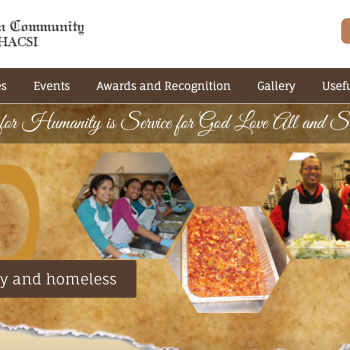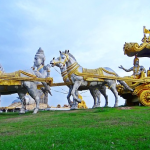It is indeed special to celebrate the start of a new year, and the new beginnings associated with it, but it is even more special when the first few days of the year includes celebrating the arrival of a new baby. The Hindu life sacrament known in Sanskrit as Simantonnayana with the literal meaning “parting of the hair,” has evolved into a baby shower, to both welcome a new baby into the family and celebrate the expectant mother. Hindus, particularly those from southern India where my ancestors hailed, consecrate this particular milestone of life with rituals and festivities. This samskara, one of the sixteen life sacraments traditionally performed by a practicing Hindu, is done at a particular time period during a woman’s pregnancy – usually ranging from the fourth to seventh month. And I recently attended such an event for a close family friend, prompting me to do a little research into the significance of this event.
Each milestone in the journey of life marked by the sixteen samskaras reflect major biological and emotional stages. Some are more amenable to be melded into a Hindu American lifestyle – such as this one which can also include the games and gifts that one would find at any baby shower. Still others are celebrated to retain the cultural underpinnings of a Hindu’s spiritual heritage – such as the namakarana, the formal name giving ceremony, and the annaprasanna – the first time a baby is fed solid food. And yet others are observed because of the Hindu foundational commitment to education – and recognition that it is through the light of knowledge acquired through education that ignorance is removed. I have joyous memories of both my children’s vidyarambha, where they were initially guided to write the Hindu sacred syllable Aum (also Om) and other alphabet: one was celebrated with grandparents and extended family in India, our spiritual motherland, and the other was a much more simple ceremony at home in the US – and of my son’s upanayanam, where he was initiated into the Gayatri mantra, and what would historically have been a formal pursuit of Vedic education.
The seemantham – a commonly used Telugu term for the Vedic ritual of Simantonnayana – is a ceremony where the expectant mother is given special treatment, including fulfilling the cravings typical of pregnancy and offered special treats to eat. She also receives special blessings from elders to ensure safe delivery of the child – and special prayers are offered to God for the healthy physical and mental growth of the child.
A traditional seemantham starts with such prayers, followed by a special ritual bath for the pregnant woman, after which she dresses in new clothes and ornaments, particularly red and green glass bangles. According to some accounts, the sound of the bangles is believed to reach the womb and comfort the fetus. But social songs more folk in nature usually accompany the more religious bhajans and classical Carnatic music. The music is supposed to be pleasant, in order to soothe the mother-to-be and the baby in her belly. The event is also a way to showcase hospitality, with festive foods made to the expectant mother’s liking, and the one I attended was no exception. As I helped with preparing delicacies and arranging things for my friend’s seemantham, it also became obvious that the pre-event preparation was the real party. Friends and family from near and far came to bless the parents-to-be, and it truly became a celebration of life, as people who had known the family over several decades, came to her parents’ home to wish them all well in this next phase of life.
Also known as valaiakappu in the south Indian language of Tamil, this event is traditionally done in a similar way in other parts of southern India: some women return to their parents’ home, only to return to their own home 40 days after delivery. But in other parts of India (where about 90% of the world’s Hindus live), rather than the expectant mother’s parents hosting the event, it is held at her in-laws’ home – so there is no one-size-fits-all approach for how Hindus celebrate the arrival of a new baby, as they are often intertwined with linguistic and cultural practices. Interestingly, the Grihya Shastras or Grihya Sutras (translated from the Sanskrit to “Household maxims or codes”) also don’t offer a uniform understanding or celebration of this samskara. These Sutras provide the rules and customs for domestic life, including rites of passage and other home ceremonies, which are widely followed to this day (and sometimes without knowing the underlying reasons). These texts do not give clear guidelines on when to do the seemantham – early or late stage of pregnancy – or whether it is a rite of passage of the baby or of the pregnant woman. And the Indian diaspora add even more variety, easily incorporating modern practices into the ancient traditions – such as the baby’s grandmother flying out across continents to help the new parents in their home for a few weeks (I was fortunate that my mom did this for me).
At this particular very Indian-American event, the baby shower and games commonly associated with it came first – the mom-to-be’s friends from school and college showed up with a variety of decorations that were decidedly American, and also reflected in the mix of snacks, themed from childhood classics such as The Very Hungry Caterpillar and If You Give a Mouse a Cookie. People were dressed in a range of outfits – casual and semi-formal Western wear to more trendy Indian to traditional silks saris. The menu for dinner – which followed the bangle-ceremony and a cake-cutting – was a blend of south and north Indian specialities, with Indo-Chinese and pasta items thrown into the mix. So syncretism was the real theme for the day, typical of the pluralistic Hindu and American approach – the same diversity that sometimes makes it difficult to agree on a single way of doing things. Yet as I attended this Hindu-American seemantham, the atmosphere around me, with all the love and laughter to celebrate the arrival of the young couple’s bundle of joy, I saw the unity in diversity, the way that pluralism is lived, and found the words of Nobel Prize-winning poet Rabindranath Tagore echoing in my mind and heart. “Every child comes with the message that God is not yet discouraged of man.”
















